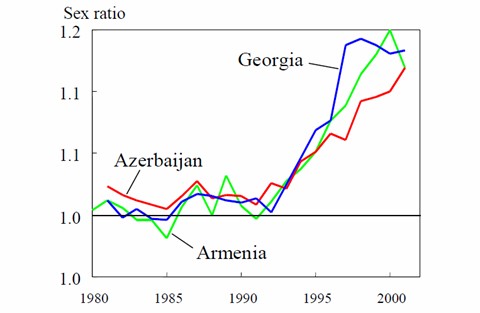
The financial crunch caused by Microkhan Jr.’s increasing appetite for food and Cookie Monster paraphernalia forced us to drop our Economist subscription this year, so we’re late to the mag’s report on the drop in female births throughout much of the world. But it’s essential reading—a disturbing look at a trend that could lead to serious economic and security woes down the line. Having experienced what it’s like to be a twentysomething male, we know firsthand that no good can come of condemning 20 percent of our Y-chromosome brethren to futures without any prospect of female companionship.
The Economist piece disappoints, though, in that it focuses almost exclusively on India and China. But what about the Caucasus, whose nations nearly top the tables in terms of male-female imbalance? Fortunately, some French and Georgian demographers are on the case, investigating why the Caucasian discrepancy jumped so markedly immediately after the collapse of the Soviet Union. They’re cautious about making sweeping conclusions, but they do seem convinced that the collapse of stingy state-run health care is partly to blame. Once in utero scans could be obtained on demand at market rates, rather than only with bureaucratic approval, couples had much more information regarding the genders of their nascent children.
The question now is whether how we incentivize Armenians, Azerbaijanis, and Georgians to resist the urge to selectively abort female children. National governments need to be very far-sighted to do this, as the consequences of gender imbalance won’t start to kick in until a decade or two down the line—when, presumably, those in power will have already ridden off into the sunset. And meddling from the international community may be unwelcome, given the sensitivity of family planning issues.
We actually fear that this is the sort of issue that won’t be resolved ’til the downsides become more palpable. In the meantime, please remind us to steer clear of Ladies Night at any Tbilisi bar over the next 15 to 20 years. Gonna be a crazy scene.


scottstev // Mar 24, 2010 at 10:58 am
Right-on with the last paragraph. You wonder why dowries (and social status of daughters) don’t increase now that there’s a shortage. You would think it’d take a generation at most.
Brendan I. Koerner // Mar 24, 2010 at 11:41 am
@scottstev: Dowries and bride prices are endlessly fascinating. Reading something about the latter issue in East Africa right now; hope to post about it in the near future.